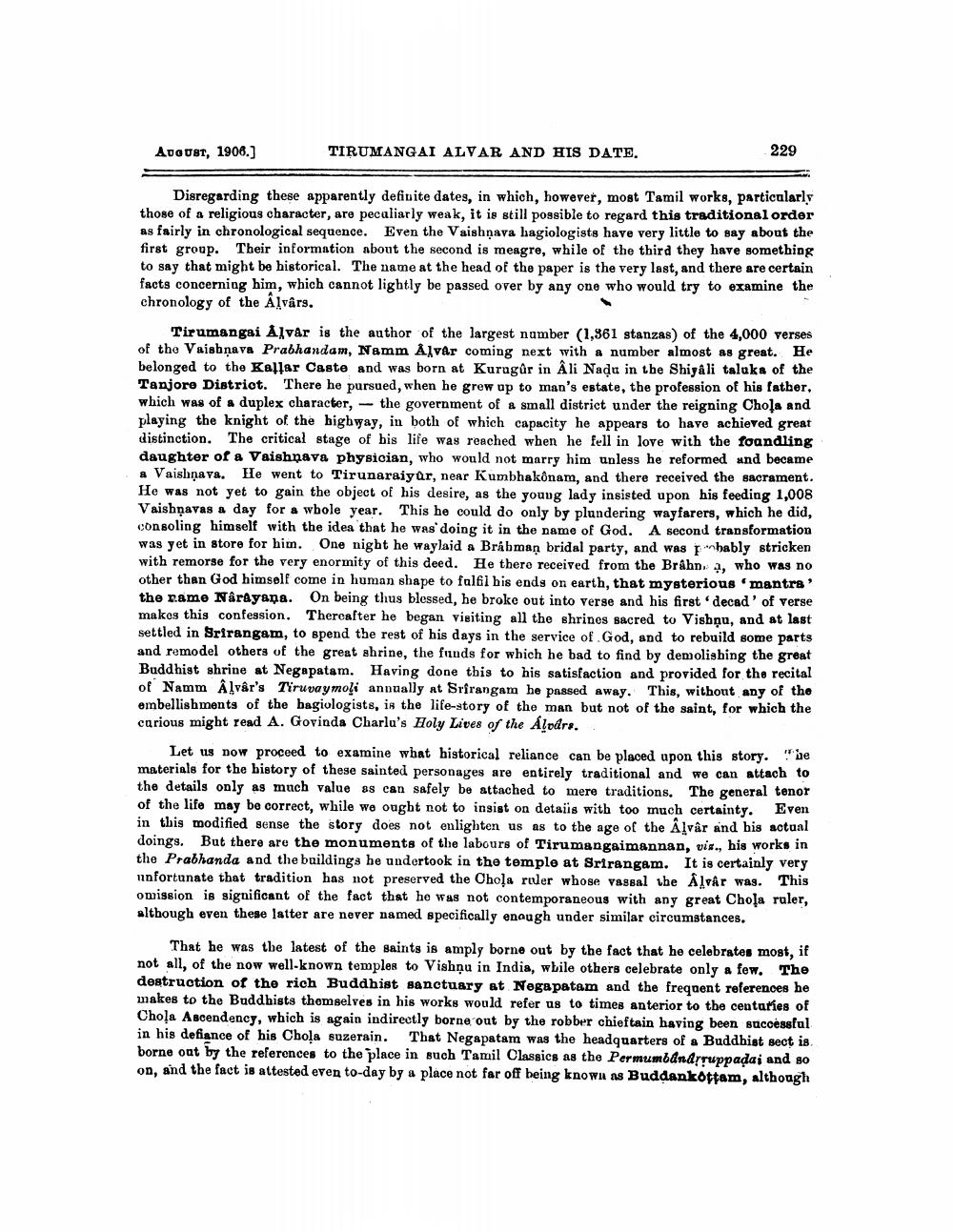________________
August, 1908.)
TIRUMANGAI ALVAR AND HIS DATE.
229
Disregarding these apparently definite dates, in which, however, most Tamil works, particularly those of a religious character, are peculiarly weak, it is still possible to regard this traditional order as fairly in chronological sequence. Even the Vaishnava hagiologists have very little to say about the first group. Their information about the second is meagre, while of the third they have something to say that might be historical. The name at the head of the paper is the very last, and there are certain facts concerning him, which cannot lightly be passed over by any one who would try to examine the chronology of the Alvârs.
Tirumangai Alvar is the author of the largest number (1,861 stanzas) of the 4,000 verses of the Vaishnava Prabhandam, Namm Alvar coming next with a number almost as great. He belonged to the Kallar Caste and was born at Kuragûr in Âli Nadu in the Shiyali taluka of the Tanjore Distriot. There he pursued, when he grew up to man's estate, the profession of his father, which was of a duplex character, the government of a small district under the reigning Chola and playing the knight of the highway, in both of which capacity he appears to have achieved great distinction. The critical stage of his life was reached when he fell in love with the foundling daughter of a Vaishnava physician, who would not marry him unless he reformed and became a Vaishnava. He went to Tirunaraiyur, near Kumbhakồnam, and there received the sacrament. He was not yet to gain the object of his desire, as the young lady insisted upon his feeding 1,008 Vaishṇavas a day for a whole year. This he could do only by plundering wayfarers, which he did, consoling himself with the idea that he was doing it in the name of God. A second transformation was yet in store for him. One night he waylaid a Brábman bridal party, and was inhably stricken with remorse for the very enormity of this deed. He there received from the Brahn , who was no other than God himself come in human shape to falfl bis ends on earth, that mysterious mantra' the name Narayana. On being thus blessed, he broke out into verse and his first decad' of verse makes this confession. Thereafter he began visiting all the shrines sacred to Vishņu, and at last settled in Srirangam, to spend the rest of his days in the service of God, and to rebuild some parts and remodel others of the great shrine, the funds for which he bad to find by demolishing the great Buddhist shrine at Negapatam. Having done this to his satisfaction and provided for the recital of Namm Alvâr's Tiruvaymoli annually at Srirangam he passed away. This, without any of the embellishments of the bagiologists, is the life-story of the man but not of the saint, for which the carious might read A. Govinda Charla's Holy Lives of the Alvdrs..
Let us now proceed to examine what historical reliance can be placed upon this story. The materials for the bistory of these sainted personages are entirely traditional and we can attach to the details only as much value as can safely be attached to mere traditions. The general tenor of the life may be correct, while we ought not to insist on details with too much certainty. Even in this modified sense the story does not enlighten us as to the age of the Alvâr and his actual doings. But there are the monuments of the labours of Tirumangaimannan, vix., his works in the Prabhanda and the buildings he undertook in the temple at Srirangam. It is certainly very unfortunate that tradition has not preserved the Chola ruler whose vassal the Alcâr was. This omission is significant of the fact that he was not contemporaneous with any great Chola raler, although even these latter are never named specifically enough under similar circumstances.
That he was the latest of the saints is amply borne out by the fact that he celebrates most, if not all, of the now well-known temples to Vishnu in India, wbile others celebrate only a few. The destruction of the rich Buddhist sanctuary at Nega patam and the frequent references he makes to the Buddhists themselves in his works would refer us to times anterior to the centuries of Chola Ascendency, which is again indirectly borne out by the robber chieftain having been successful in his defiance of his Cbola suzerain. That Negapatam was the headquarters of a Buddhist sect is borne out by the references to the place in such Tamil Classics as the Permumbandsruppadai and so on, and the fact is attested even to-day by a place not far off being known As Buddankottam, although




